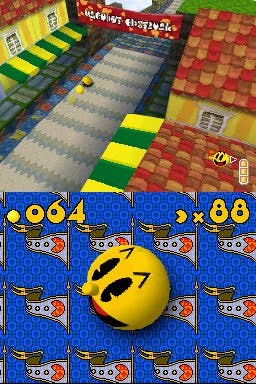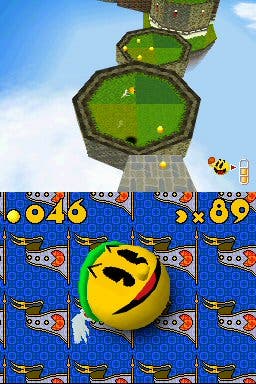Pac n' Roll
Does Pacman have a ghost of a chance on the DS?
Well, this is either going to open with some sort of remark about the 25th anniversary of Pacman, or about how the DS is finally coming into its own. Spin the wheel... tikka tikka tikka tik tik tik tiiik tiiiiik... clunk. It's the DS.
This is the moment that you can finally say it's worth owning a DS. Sure, Zoo Keeper is a lot of fun. Certainly, there were a couple of novel ideas in WarioWare: Touched. And yes, I'd imagine you have your own unique defense for any number of the obscure titles that have trickled out in the machine's first 10 months. But now, at last, the awkwardness is gone, and the stylus is entirely justified. Nintendogs welcomes in the crowds, Advance Wars: Dual Strike pleases those in the know, Phoenix Wright delights the obscurists, and Kirby: Canvas Curse demonstrates that innovation brings in surprise results.
Pac 'n Roll fills in a very vital, and oft neglected role, in the mainstream realisation of a console: it's plain good. Not outstanding, not worth buying a DS to play. But solid, entertaining, good. Also, Pacman is 25. Happy birthday old man.
While there's a danger that a developer's desperation to make the touch screen a necessity could impede the player's enjoyment - always, always a bad thing - in the meantime let's hope everything is as industriously competent as Pac 'n Roll. In fact, here is a game that could not exist were it not for the pen-on-paper feel - not even if replaced by a mouse. This is exactly what we're after.

Naturally the top screen carries the action, the bottom the interaction, but what makes PNR such a pleasure is the feeling of complete connection with your little avatar. To roll forward you roll the large image of Pac forward, back, left and right the same. The close-up Pac spins crazily, his ludicrously enthusiastic face looping about, until you stab the stylus down, stopping him dead in his tracks. To send him flying, whip the stick from the middle hard into the top. It's taught instantly in some superb in-game tutorials (entirely optional), with no patronising messing around, and no essential information left out. Balancing your tutorial correctly is a tough job - PNR's is so seamless and intuitive that you almost forget it's happening. A couple of pick-ups are thrown in - one makes you heavier, slower, and able to break things, the other lighter, floatier, and able to drift after lauching off ramps. And that's your lot. And it's all you need.
This control in place, all PNR needs to do is lay out interesting levels in which you can apply this knowledge, and improvise solutions to the questions they ask. Note: needs to do. There's a certain ambiguity here, a lack of commitment. It's that clever technique reviewers often use to reflect the nature of the game. We're so terribly clever.
When PNR gets it right, it gets it so very, very right. There's a maze-me-do course in front of you, and your carefully limited toolbelt of available controls to traverse it. Throw in the required ghosts, yellow pellets to collect, and bonus pellets that turn the ghosts blue and make them vulnerable to you, and you've got everything that is Pacman, in a whole new game. And so long as those levels remain interesting, puzzle-filled, and tough to beat, all is well. Disappointingly, in many of the 30 or so courses, this is not the case. Instead it becomes little more than a case of rolling from one end to the other, without ever feeling even vaguely vulnerable. For the majority of the game, I blitzed through, accumulating extra lives in their tens, not sure what I'd ever need them for.

And then, as is far too frequently the case, the difficulty curve is exponential. After actually getting simpler by the fourth chapter, things demonstrate a significant sign of hope when inside the ghost's castle, but then smack face first into a wall. Out of nowhere, PNR suddenly becomes Monkey Ball, with instant deaths cascading down like a blood-soaked waterfall. Except, you know, without the actual blood. Now this isn't a matter of suddenly running out of lives. A game-over merely punishes you by counting the number of game-overs received, and presumably causing you to feel a bit rubbish, but it resets you with a decent five lives each time. The trouble is, it wasn't a quarter this hard ten minutes ago, and now it's not fun all of a sudden. You can't help but think that halfway between the majority of the game and the final levels might have been the perfect pitch. As it is, it goes: fun - fun - fun - fun - fun - NOT FUN ANY MORE.
There's an atrocious story that really could have been done without. Something about some Pac person getting captured by some uber-ghost conjured by the regular baddies in an attempt to wipe out their yellow ball foes. But then as you defeat the mean ghost in each of the one-attempt-needed boss levels, you're congratulated on having rescued some member of the extended Pac family. It's lovely that I rescued my dog, or the baby daughter of some other ball, but it would have been a heck of a lot more satisfying if I'd been told they were captured in the first place, or even that they existed. All the extraneous story is so strained that the whole game would have felt significantly more solid if they'd only built it as a straight puzzler. We don't need to know why the monkeys have to collect the bananas from the increasingly dangerous platforms, and we no more need to know or care why the arcade-classic Pacman wants to collect all the dots. It's no different here.
Boosting things considerably is the repeat-playing of levels. Once completed, the time trial mode appears. Not enormously inventive, but certainly fleshing things out, it perhaps goes some way to explaining why the earlier levels are so over-simplistic. Complicated manoeuvres would somewhat destroy the thrill of a time chase.

Even better is the unlockable Challenge mode; each level's challenge becoming available seemingly at random when other tasks are completed elsewhere. Whether it's killing a certain number of ghosts within a time limit, finding a series of hidden objects, or even completing levels without picking up a single pellet, each displays a wealth of intelligence and cunning design that might perhaps have been better placed as the main game. Seemingly impossible tasks can be poked and prodded until finally their solution becomes clear. However, when the game becomes more experimental in this way, it's a real shame that lives can be lost in the process - it doesn't seem particularly fair, or necessary, to punish you for improvising.
Pac 'n Roll is a triumph of interaction. Rarely does the connection between control method and in-game result feel so solid. And the often excellent Challenge levels remind of the brilliance of '80s classic Marble Madness or the Monkey Ball games. In fact, PNR makes you certain that the DS is the machine on which Monkey Ball was always destined to appear. It remains a huge shame that the main game fails to engage quite so severely once the first few chapters are complete. A lack of imagination, or imagination put into all the wrong places, means that no number of extra ways to play a level prevents the game from feeling woefully short. There are some pleasant hidden treats, such as the unlockable full version of the original Pacman, but none of it feels connected enough to provide the grandiose of a gaming classic.
So as we began, Pac 'n Roll fills that role that the DS has so far lacked - the good game. If the mechanics were applied to stronger level design, then it would plant its flag firmly in 8/10 territory. As it is, it remains well worth playing, but not a necessity for any DS shelf.

